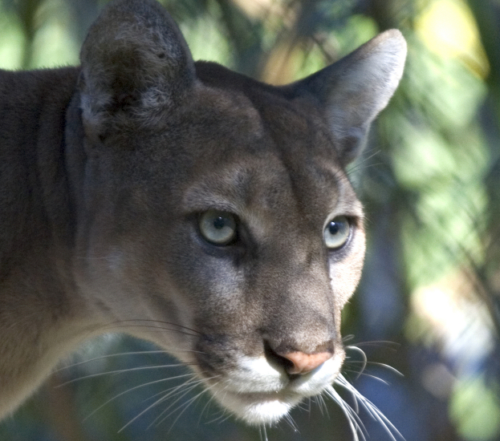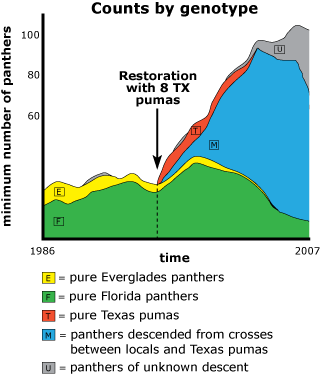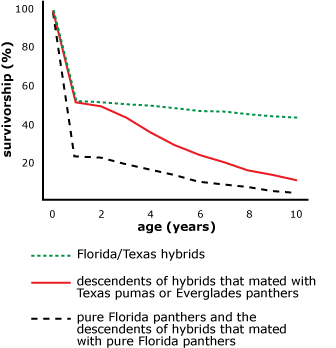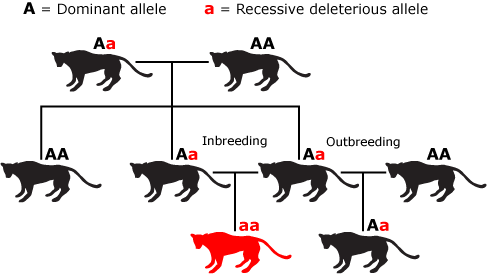
This fall, biologists announced the apparent success of a last-ditch conservation effort: the Florida panther, once slated for extinction, has been given a second lease on life by the infusion of genetic variation. In the 1900s, this population nosedived because of hunting and habitat loss. By the 1990s, there were fewer than 30 Florida panthers left. To make matters worse, those survivors were in bad physical shape. They were riddled with diseases and parasites and had poor sperm quality and low fecundity, as well as a host of problems like undescended testicles, kinked tails, and heart defects. Scientists predicted that the Florida panther would be extinct within 20 years and, in 1995, formulated a bold plan to save them.
Where's the evolution?
The conservation plan involved improving the genetic status of the population with new blood. In 1995, eight female pumas from Texas (a different subspecies of panther) were moved into the area and took up residence with their Florida cousins. How could just eight panthers help save a whole population? The new panthers brought with them new gene versions, which help counteract two negative side effects of small population size: reduced genetic variation and inbreeding. To understand how the conservation plan worked, it helps to understand the evolutionary importance of genetic variation and the evolutionary underpinnings of inbreeding depression.
Genetic variation refers to all the different gene versions that are present in a population. In general, when a population loses a lot of individuals (i.e., decreases in size), its genetic variation goes down as well. This makes intuitive sense. The fewer individuals in a population, the fewer different gene versions they may carry. Over long time scales, decreased genetic variation can be a problem for a population because genetic variation is the raw material of evolution. Natural selection acts on the genetic variation present in a population, favoring some gene versions over others and eventually producing adaptations that allow individuals to thrive in new circumstances. So without a sufficient amount of genetic variation, a population cannot evolve in response to changing environmental conditions. Hence, bringing in new panthers probably improved the Florida panthers’ evolutionary potential.
Over short time scales, genetic variation is important for a population’s survival as well. For example, a genetically variable population is more resistant to pathogens and parasites. This occurs at two different levels. At an individual level, populations with high levels of genetic variation generally include many individuals who are heterozygous — that is, they carry two different gene versions — at important locations in the genome. Individuals with many heterozygous genes are less likely to be susceptible to diseases and parasites than are individuals with many genes that are homozygous (i.e., the individual carries two copies of the same gene version for a particular gene). That’s because individuals that are heterozygous for genes involved in parasite and pathogen resistance have twice the chance of carrying the right gene version to resist the pathogen-of-the-day than do individuals homozygous for those genes. It’s a bit like buying two tickets for a raffle instead of one. The more tickets you have, the more likely one of them will be a winner. The same reasoning applies at the population level. A genetically variable population is likely to include some individuals who happen to be genetically resistant to the disease or pest — enabling the population to survive to the next generation, even if many individual animals die or become sick. For the Florida panthers, bringing in new blood increased heterozygosity, improving the health of individuals, and made the population less likely to be wiped out by a single disease or parasite.
Another genetic side effect of small population size is inbreeding — a situation in which individuals mate with their close relatives. In very small populations, like that of the Florida panthers, this happens simply because the population is so small that all the individuals are closely related to one another. The offspring resulting from inbreeding tend to have health problems and lower reproductive success. This is known as inbreeding depression — and was seen in the Florida panthers in the form of poor sperm quality, low fecundity, undescended testes, kinked tails, and heart problems. Inbreeding depression occurs because of a quirk of natural selection and genetics. As natural selection acts on a population, it weeds out genes that have disadvantageous effects, but it can only weed out these genes if they are actually expressed in an individual. For dominant gene versions, that’s no problem. Individuals carrying dominant genes with a detrimental effect will be selected against, and eventually, these genes will be purged from the population. For recessive gene versions, however, the story is a bit different. Recessive genes are only expressed when an individual carries two copies of them. Once natural selection has removed most of the detrimental recessive genes from a population, these seldom wind up paired with an identical copy and are effectively hidden from the effects of natural selection. This means that most populations carry many deleterious recessive gene versions that are very rarely expressed — except in cases of inbreeding. Closely related individuals are likely to carry the same deleterious recessive gene versions and pass two copies of that gene on to their offspring. Hence, the offspring of inbred matings tend to express many deleterious recessive genes, resulting in lower fitness. Introducing the new panthers to the Florida population helped reverse the effects of inbreeding by bringing in new gene versions that masked the negative effects of the recessive gene versions already present in the Florida panther population.
With an evolutionary perspective, it’s easy to understand why Florida panthers once seemed doomed. Their small population size not only put them closer to extinction in terms of sheer numbers, but also introduced the genetic risks of reduced genetic variation and increased inbreeding. Similarly, an evolutionary perspective helps explain why this conservation experiment was a success. Bringing in eight new panthers might seem like too little too late, but in fact, the genetic diversity they brought with them seems to have had significant benefits for the population. The new gene versions from the eight panthers outlasted their original carriers and have been passed down through the generations to individuals alive today. Now, the population size has tripled, genetic variation is up, and signs of inbreeding are down. And over the past 30 years, the panthers have gotten a further boost from increased legal protection and the establishment of additional protected panther habitat, as well as simple measures, like new freeway underpasses that help the cats avoid vehicles. Of course, the Florida panther is still endangered and will need continued protection and even more habitat to survive for the long term — but, as we’ve seen, understanding the evolutionary underpinnings of the panthers’ plight will help biologists develop effective conservation plans for their future.
Primary literature:
- Charlesworth, D., and Willis, J. H. (2009). The genetics of inbreeding depression. Nature Reviews Genetics. 10: 783-796. Read it »
- Johnson, W. E., Onorato, D. P., Roelke, M. E., Land, E. D., Cunningham, M., Belden, R. C. ... O'Brien, S. J. (2010). Genetic restoration of the Florida Panther. Science. 329: 1641-1645. Read it »
News articles:
- An explanation of the research from Wired
- A summary of the story from National Geographic News
Understanding Evolution resources:
- A tutorial on genetic variation
- A brief explanation of inbreeding depression
- A reader on the many ways in which evolutionary theory informs conservation efforts
Background information from Understanding Global Change:
- Why is genetic variation so important to evolution?
- How and why does genetic variation affect a population’s ability to survive attacks by pathogens and parasites?
- Advanced: Read this news brief on genetic variation in cheetahs. According to that article, female cheetahs seek out mates that are distantly related to one another. Compare and contrast female cheetah’s mating strategy to conservation biologists’ plan to save the Florida panther by introducing Texas panthers. Be sure to include an explanation of how each affects the genetic variation in the population.
- Review this figure adapted from the original journal article on the restoration of the Florida panther:

- Were panthers descended solely from the original Florida and original everglade populations successful? How do you know this?
- Describe how the panthers’ population size changed over time.
- Advanced: Review this figure adapted from the original journal article on the restoration of the Florida panther. This graph shows survivorship curves — the percent of individuals in the group that survive to various ages:

- Which panthers are most likely to survive to the oldest age?
- Which panthers exhibit the highest mortality at young ages?
- According to this graph, at what age range are panthers most likely to die?
- What does the slope of a line in a survivorship curve indicate?
- Give a potential genetic explanation for why the descendents of hybrids and other lineages don’t survive as well as the hybrids themselves.
- Teach about genetic variation: In this lesson for grades 9-12, students conduct a classwide inventory of human traits, construct histograms of the data they collect, and play a brief game that introduces students to major concepts related to human genetic variation and the notion of each individual's uniqueness.
- Teach about genetic variation and conservation: This lesson for grades 9-12 uses paper chromatography to simulate electrophoresis of DNA. The problem posed is to identify the genetic similarities among several sub-species of wolf in order to provide information for a conservation/breeding program.
- Teach about genetic variation and conservation: This news brief for grade 9-16 explains how the evolutionary implications of female cheetahs' mating strategies may help conservation efforts targeting these endangered animals. This article comes with a set of discussion questions for use in the classroom, as well as links to related lessons.
- Johnson, W. E., Onorato, D. P., Roelke, M. E., Land, E. D., Cunningham, M., Belden, R. C. ... O'Brien, S. J. (2010). Genetic restoration of the Florida Panther. Science. 329: 1641-1645.

